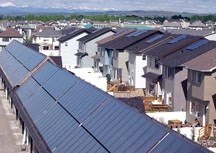The Drake Landing solar community has been a world leading development since day one and the Town of Okotoks and its partners in the development want to take it to another level.
Two new projects are planned with one to improve the energy efficiency of the existing community and a second with an eye to the future of the technology.
Dawn Smith, Okotoks sustainability co-ordinator, said a large-scale feasibility study will be done to prove the economic viability of the technology to see how big a solar development would need to be to make financial sense.
The existing Drake Landing solar development was intended to prove the viability of the technology, which she said it has.
However, it was always known it would be too small to be economical, said Smith.
“If you crunch the numbers, it wouldn’t pay back, it would be much too small,” she said. “It was always intended to be a research and development project. The didn’t want to make it too big, they wanted to see if it would work.”
The study’s $175,000 price tag will be fully funded by Natural Resources Canada. The costs to the Town would be limited to things like participation of staff members in conferences, workshops and reviewing the final report.
The study is expected to take a little more than a year to complete and the final report should be issued by March 31, 2012.
Smith said there are a lot of unknowns for a large-scale solar community. They don’t know how big it would need to be to be economical. They don’t know how it would be phased. They don’t know if more than one energy centre would be needed. They don’t know how it would be laid out.
They hope to answer these issues and more with the study.
“I think that’s what’s complicated about it, they don’t know,” she said. “That’s the whole point of the research.”
She said they will look at different styles of housing such as single family homes, town homes or row housing and multi-family, condo-type developments.
The Drake Landing Solar Community includes 52 houses. Solar panels on garages behind the homes collect solar energy, which is used in the summer to heat the ground near the energy centre. In the winter, this ground heat is used to heat water, which heats the homes.
The system reached a world-leading benchmark last year, deriving 80 per cent of energy to heat homes from solar energy. Natural gas is used to make up the remaining energy needs. The goal is to derive 90 per cent of the energy needed to heat homes from the sun.
It’s a benchmark she expects could be reached this year, ahead of schedule, and potentially exceeded.
She doesn’t know if a large-scale development will be built once the study is complete, but she said it’s likely.
If so, mayor Bill Robertson want Okotoks to be considered.
However, he said there could be challenges. Given the possible size of a larger-scale geothermal development, Robertson said the issue is whether there is enough land in town to accommodate it.
“I would be ecstatic if they would come here,” he said. “At the same time, we had the first drake landing one so I really can’t complain too much if the government decides to put it somewhere else.”
Whether a potential future development is built in town or not, Robertson said Okotoks will be participating in the large-scale feasibility study.
In the mean time, new solar panels are going to be installed at the energy centre at the heart of the Drake Landing community.
At present, the centre pulls electricity from renewable sources on the electrical grid.
The solar panels will provide enough electricity to operate the facility.
“We want to make it on-site energy neutral,” said Smith.
Natural Resources Canada is paying the entire $130,000 cost of the solar panels. It’s expected the panels will be installed by March 31 this year.
An existing set of solar panels on the energy centre are currently used for a back up battery system.
The new panels will also eliminate the need for an emergency generator to be brought to the centre in the event of an extended power outage.
A number of things were done last year to reduce electricity use at the energy centre, including using fewer lights, replacing lights with higher efficiency bulbs and improved exhaust fan controls.
“Those efficiencies cut back a percentage of the energy use and now they need to cut back the rest through the solar PV panels,” said Robertson.




